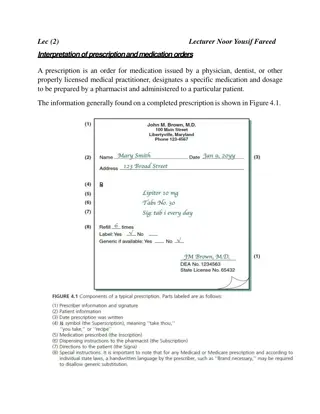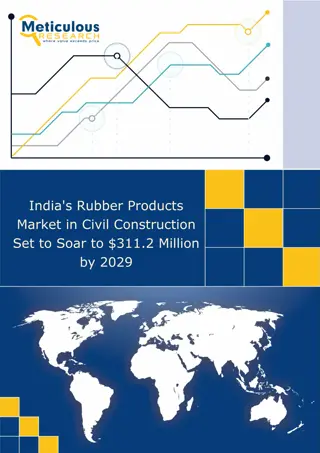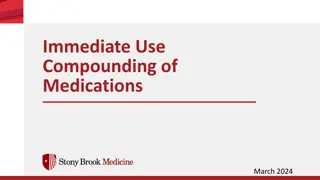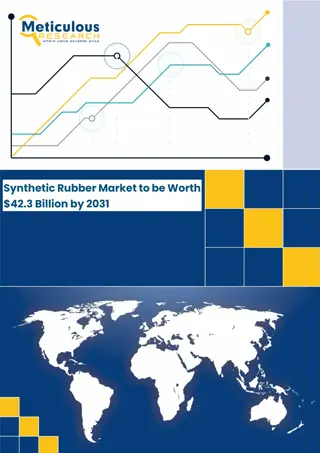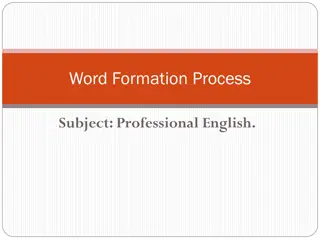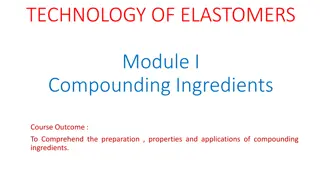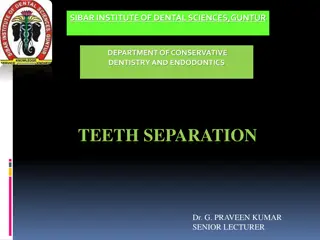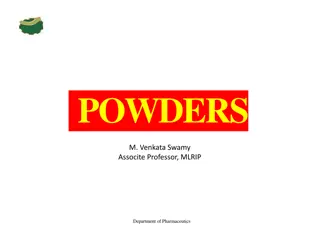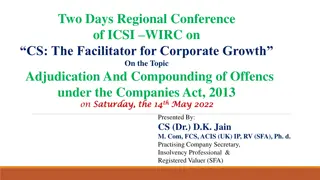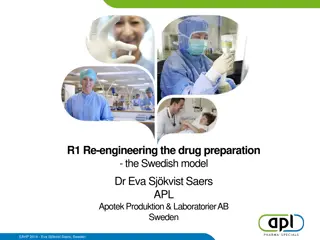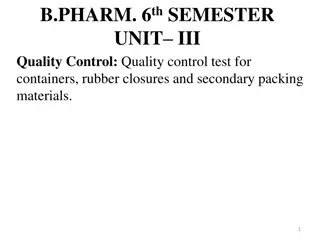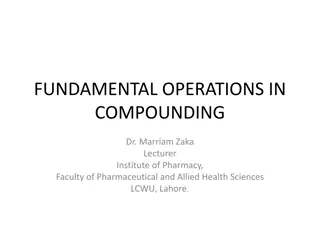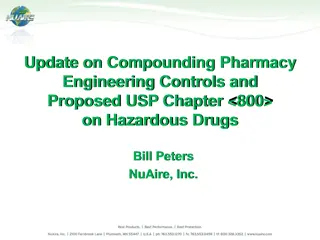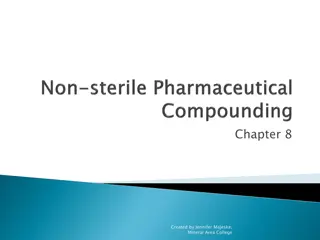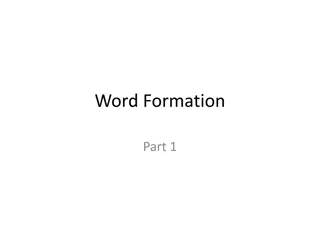Rubber Compounding: Principles, Objectives, and Development
Explain the principles of rubber compounding, detailing the design of compounds to meet specific vulcanizate properties. Explore the stages of product development, objectives of compound development, and the vital factors in achieving desirable rubber properties. Learn about major compounding objectives, ranging from resistance to degradation to compound and process requirements.
Download Presentation

Please find below an Image/Link to download the presentation.
The content on the website is provided AS IS for your information and personal use only. It may not be sold, licensed, or shared on other websites without obtaining consent from the author. Download presentation by click this link. If you encounter any issues during the download, it is possible that the publisher has removed the file from their server.
E N D
Presentation Transcript
MODULE IV MODULE IV COMPOUNDING FOR THE VULCANIZATE COMPOUNDING FOR THE VULCANIZATE PROPERTIES PROPERTIES
4.1.0. Able to apply principles of compounding for the design of various recipes to meet the vulcanizate properties 4.1.1. Explain the general principles of compounding, chart out the properties of elastomers. 4.1.2. Describe the elements to be considered for preparing a formulation and a product. 4.1.3. Describe the method for calculation of specific gravity and volume cost of a compound with examples. 4.1.4. Explain compounding to meet processing requirements. 4.1.5. Explain the effect of particle size and structure of filler on processing and vulcanisate properties. 4.1.6. Design compounds for a particular shoreA hardness and modulus using black and nonblack fillers. 4.1.7. Describe the factors to be considered for compounding specific vulcanisate properties such as abrasion resistance, hardness, tensile properties, tear resistance, oil resistance, heat,light,flame, oxygen and ozone resistance.
STAGES OF PRODUCT DEVELOPMENT STAGES OF PRODUCT DEVELOPMENT (mixing, moulding, extrusion, calendaring, fabrication of product, Compound Design Lab Evaluation curing, etc ), Testing of processing properties Compound Modification (if reqd.), Analysis of feedback and of finished product Validation of manufacturing Field trials process.
Objective of Rubber Compounding To secure certain properties in the finished product to satisfy service requirements. To attain processing characteristics necessary for efficient utilization of available equipment. To achieve the desirable properties and processability at lowest possible cost. The most important factor in compounding is to secure an acceptable balance among demands arising from the above three criteria ( final vulcanizates properties, cost and processability)
Major Objectives of Compound Development Resistance to Degradation Heat, Oxygen, Ozone Flame Liquids Light Metal poisoning Miscellaneous property requirements Low temperature flexibility Electrical properties Swelling Permeability Bonding to metals & textiles Contact with food stuff and drugs etc.
Major Objectives of Compound Development Process Requirement Proper mixing ( Incorporation, dispersion, distribution and plasticisation) Viscosity/process safety Stickiness and tackiness Shaping ( Calendaring, Extrusion, Assembling and Moulding) Compound property requirement Hardness Stress-strain properties Abrasion resistance Hysteresis & Set properties Resistance to cut growth, fatigue, flex cracking
GENERAL PROPERTIES OF ELASTOMERS SUMMARY CHART GENERAL PROPERTIES OF ELASTOMERS SUMMARY CHART
GENERAL PROPERTIES OF ELASTOMERS SUMMARY CHART GENERAL PROPERTIES OF ELASTOMERS SUMMARY CHART
EFFECT OF PARTICLE SIZE AND STRUCTURE OF FILLER ON PROCESSING AND VULCANIZATES PROPERTIES Filler particle size is the most important property which influences reinforcement Requirement for rubber reinforcement is sufficiently small domain size, < 1 m. The most important single factor which determines the degree of reinforcement is the development of a large polymer-filler interface. It can be provided only by particles of colloidal dimensions
EFFECT OF PARTICLE SIZE AND STRUCTURE OF FILLER ON PROCESSING AND VULCANIZATES PROPERTIES
COST OF COMPOUND COST OF COMPOUND CALCULATE THE SPECIFIC GRAVITY AND COST PER KILOGRAM OF THE FOLLOWING COMPOUND
COST OF COMPOUND COST OF COMPOUND
DESCRIBE THE METHOD FOR CALCULATION OF DESCRIBE THE METHOD FOR CALCULATION OF SPECIFIC GRAVITY SPECIFIC GRAVITY Design a NR compound for specific gravity 1.155 by using HAF as filler.
Design a NR compound for specific gravity 1.155 by using HAF as filler.
Design a NR compound for specific gravity 1.155 by using HAF as filler.
Design a NR compound for specific gravity 1.178 by using SILICA as filler.
Design a NR compound for specific gravity 1.178 by using SILICA as filler.
Design a NR compound for specific gravity 1.178 by using SILICA as filler.
HARDNESS HARDNESS Measure of the resistance a material has to indentation Gives a measure of the modulus at low strains. Hardness and modulus of a vulcanizates are normally increased by the use of particulate fillers, especially carbon black and silica. Compounding which produces increases in hardness also produces increases in the higher strain moduli values. Softeners and plasticizers reduce hardness Mineral oils are widely used in general purpose polymers as low cost softeners, produces a hardness drop of 1 IRHD for each two parts added.
HARDNESS HARDNESS phr required for 1 unit increase in Hardness Polymer Hardness NR 37-40 SBR 39-41 CR 41-43 NBR 42-44 2 3 5 7.9 6.6 1.6 3.3 4.1 5.6 8.4 1.5 2.2 4.5 5.0 5.0 Ppt. Silica Calcium silicate Hard clay Soft clay Whiting
NR SBR IIR CR PBR NBR EPDM Black ASTM Dsgn DBP 1.5 1.8 1.3 1.2 2.2 1.7 2.4 SAF N110 113 1.7 2.0 1.5 1.3 2.5 1.9 2.7 ISAF N220 114 1.9 2.3 1.7 1.5 2.8 2.1 3.0 HAF N330 102 2.3 2.8 2.1 1.8 3.4 2.6 3.7 FEF N550 119 2.5 3.1 2.3 2.0 3.8 2.9 4.1 GPF N660 90 2.8 3.4 2.5 2.2 4.2 3.2 4.5 SRF N774 70 2.1 2.6 1.9 1.7 3.2 2.4 3.4 HAF- LS N326 72
DESIGN COMPOUNDS FOR A PARTICULAR SHORE A HARDNESS AND MODULUS USING BLACK AND NONBLACK FILLERS DESIGN NR COMPOUNDS OF 40,50,60,70 SHORE A HARDNESS USING HAF AS FILLER Base hardness of NR = 38 Shore A Filler to oil ratio = 10: 1 As a thumb rule, as the amount of filler loading increases, there will be a corresponding increase in hardness. 1.9 phr of HAF will increase 1 shore A hardness. 2 phr of oil will decrease 1 shore A hardness.
Required Hardness ( Shore A) 40 50 60 70 Balance Hardness ( Shore A) 2 12 22 32 Amount of HAF required for increase in hardness 2*1.9 12*1.9 22*1.9 32*1.9 =3.8~4 =22.8~23 =41.8~42 =60.8~61 Amount of Oil required 4/10 23/10 42/10 61/10 =0.4 =2.3 =4.2 =6.1 Decrease in hardness value due to oil addition (2phr oil) 0.4/2 2.3/2 4./2 6.1/2 =0.2 =1.15 =2.1 3.05 0.2*1.9 1.15*1.9 2.1*1.9 3.05*1.9 Amount of HAF required to compensate oil addition =0.38~0.4(0.5) =02.185~2.2 =3.99~4 =5.795~5.8 (6) Total amount of HAF required 4+0.5=4.5 23+2.2=25.2 42+4=46 61+6= 67 Total amount of process oil required 4.5/10=0.45 25.2/10=2.52 46/10=4.6 6.7/10=6.7
FORMULATION BASED ON CALCULATED VALUES Ingredients 40 Shore A 50 Shore A 60 Shore A 70 Shore A Natural Rubber 100 100 100 100 ZnO 4 4 4 4 Stearic acid 2 2 2 2 Antioxidant SP 1 1 1 1 HAF 4.5 25 46 67 Process Oil 0.45 2.5 4.6 6.7 CBS 1.2 1.2 1.2 1.2 TMTD 0.2 0.2 0.2 0.2 Sulphur 2.5 2.5 2.5 2.5
DESIGN COMPOUNDS FOR A PARTICULAR SHORE A HARDNESS AND MODULUS USING BLACK AND NONBLACK FILLERS DESIGN NR COMPOUNDS OF 40,50,60,70 SHORE A HARDNESS USING ISAF AS FILLER DESIGN NR COMPOUNDS OF 40,50,60,70 SHORE A HARDNESS USING GPF AS FILLER DESIGN NR COMPOUNDS OF 40,50,60,70 SHORE A HARDNESS USING SILICA AS FILLER
COMPOUNDING FOR SPECIFIC VULCANISATE PROPERTIES Tensile strength Force per unit area of original cross-section which is required to break the test specimen. At relatively low hardness levels, highest tensile strength are more easily obtained using high gum strength polymers which crystallise on stretching such as NR, CR, IR. Other polymers such as SBR, NBR and BR shows low gum strength, requires fine particle size reinforcing fillers to develop maximum strength. Optimum levels vary from 30-60 phr. Resistance to abrasion Fine particle size fillers improves abrasion resistance Optimum levels for maximum reinforcement 50 phr Adjusted by blending rubbers ( NR/PBD has good abrasion resistance than NR alone)
COMPOUNDING FOR SPECIFIC VULCANISATE PROPERTIES Resistance to tear Reinforcing fillers are not generally producing a noticeable effect in tear properties Coarse fillers generally reduce tear values of mineral origin , particularly of large particle fractions Resinous processing aids like CI resin, petroleum resins , phenolic resins are capable of improving tear resistance Tear resistance falls appreciably with increasing temperature Resistance to ozone When stretched, vulcanizates are exposed to ozone, even at low concentrations. Particularly under dynamic conditions, cracking develops at right angles to the direction of strain, the rate of cracking varying markedly from one polymer to another and being influenced by the compounding employed. P-phenylene diamine and their derivatives can be used as antioxidants as wells as antiozonants.
COMPOUNDING FOR SPECIFIC VULCANISATE PROPERTIES Resistance to light and ozone UV region of the spectrum has a much higher potential energy than the Visible or IR regions, the level being of an order capable of breaking down organic molecules. In exposed vulcanizates, this shows itself as discolouration, surface embrittlement or break up in which oxygen also plays a part. Carbon black, barium sulphate, calcium carbonate etc. have good UV reflectance characteristics. Resistance to flame Halogen containing polymers such as CR produce vulcanizates which are self-extinguishing. Tricresyl phosphate, liquid chlorinated paraffin wax, antimony trioxide etc. can be used as processing aids. The flame resistance of NBR can be improved by blending with PVC and using tricresyl phosphate plasticisation.
COMPOUNDING FOR SPECIFIC VULCANISATE PROPERTIES Resistance to heat Careful choice of cross linking systems and choice of other compounding ingredients can increase appreciably the maximum service temperature of a polymer. Softeners, processing aids and plasticisers should be chosen so that they have long term thermal stability at the anticipated service temperature and are of low volatility.


